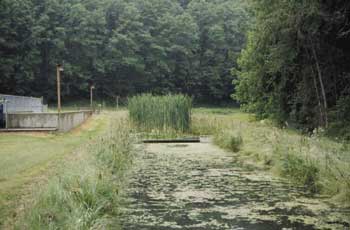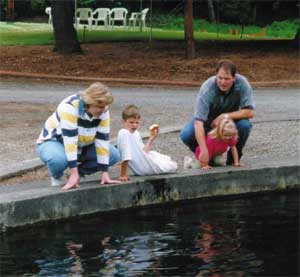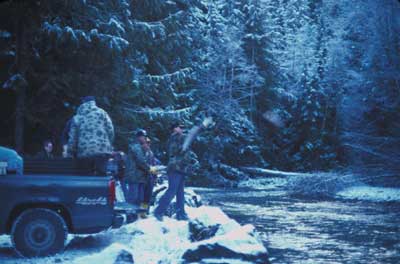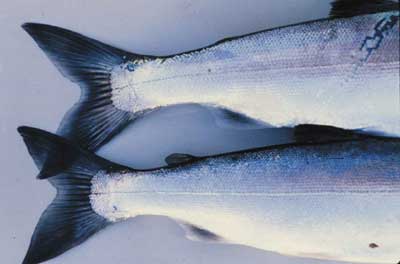State Representative Jim Buck

Improvements are underway to reduce hatcheries' effects on natural systems. Here, the Department of Fish and Wildlife constructed a wetland to filter hatchery wastewater before it returns to the river.
Hatcheries
| "Hatcheries will play an increasingly important role in the re-introduction of wild salmon in areas where they have historically spawned." State Representative Jim Buck |
 Improvements are underway to reduce hatcheries' effects on natural systems. Here, the Department of Fish and Wildlife constructed a wetland to filter hatchery wastewater before it returns to the river. |
| our goal
Hatchery practices meet wild salmon recovery needs. |
 Hatcheries near cities, like this one in Vancouver, are a good place for families to learn about fish. |
our challenge
When hatcheries were first being built over one hundred years ago, there was a belief that technology could solve all the problems created for wild salmon by over-fishing, destructive forest practices, pollution, urbanization, and dam-building. This optimism created an approach to hatcheries management that persisted for most of the 20th century: the sole purpose of hatcheries was to provide fish for harvest in order to sustain both commercial and sports fisheries. The first hatcheries opened in the 1870s. In the 1960s, the introduction of pellet fish food significantly increased the productivity of hatcheries. By the early 1990s, about 95 percent of the coho, 70 percent of the spring chinook, more than 50 percent of the fall chinook, over 80 percent of the summer chinook, and 70 percent of the steelhead in the Columbia-Snake River system were hatchery fish. What we've since learned is that hatchery fish often competed with wild salmon for dwindling freshwater habitat. Mass rearing in hatchery ponds also bred diseases, which then could be introduced into wild fish populations. And because not much was known about the subtlety and complexity of the way wild salmon evolve and adapt to specific streams, hatcheries often transferred eggs from one river system to another. These hatchery fish then interbred with wild fish, and sometimes compromised the genetic suitability of wild salmon for their native streams. In addition, some hatcheries actually blocked the streams on which they were located, making it impossible for wild fish to reach their spawning grounds. |
| our progress |  Salmon carcasses play an important part in nourishing a healthy watershed. Many plants and animals rely on decaying salmon as food sources. The Washington Department of Fish and Wildlife has begun a program of freezing salmon after they return to hatcheries and have spawned, then later tossing these "carc-sicles" into nutrient-poor streams. |
|
The role of hatcheries is changing dramatically. Deeper understanding of the problems hatcheries have created and of the role they have to play in the recovery of salmon, and a new recognition of the limits of our scientific knowledge are profoundly changing the way hatcheries are managed. Today, producing fish for harvesting is balanced with a second mission: to help conserve wild salmon, and, where they are endangered or threatened, to help them recover to healthy, sustainable levels. This mission will take on even more importance in the years to come. To lay the groundwork for a comprehensive re-tooling of hatcheries, the first-ever scientific review of federal, state and tribal hatchery practices is now underway. Even in advance of the results of this review, state hatcheries have changed many of their practices. And many of these changes have been underway for twenty years or more. Work has begun to redesign some hatcheries to provide safe passage for wild fish. Hatchery operations are timed so that young fish are released when they will not compete with wild fish for food. Guidelines have been developed to protect the genetic integrity of wild salmon, and state, tribal, and federal governments are working together to complete Hatchery and Genetic Management Plans for hatchery operations that may affect wild salmon. An Independent Scientific Review panel has also been asked to develop a scientific framework for hatchery operations. Already there are examples of how hatcheries can play a vital role in saving endangered wild salmon. In 1976, biologists estimated that fewer than 50 wild spring chinook salmon remained in the North Fork of the Nooksack River-the result of excessive fishing, timber practices and other factors. To guard that stock against immediate extinction, biologists from the Washington Department of Fish and Wildlife captured these fish and moved them to the nearby Kendall Creek Hatchery. These native salmon are bred at the hatchery, and they return as adults to the hatchery, where they help propagate future generations. A scientific committee, which includes representatives from the Nooksack and Lummi tribes and WDFW, meets regularly to chart the course of their recovery. For the past five years, an average of 2,000 adult wild spring chinook has returned to the hatchery, and in 1999 an additional 900 fish returned to the river itself. This successful restoration project took many years. But this experience has been the source of new knowledge about how to succeed in the delicate task of preserving and restoring wild fish when they are at the brink of extinction. Today, one third of the 100-plus hatcheries in Washington state are involved in recovering wild salmon runs. Still, there is a great deal more to do. Some hatcheries are a century old, and urgently need to be improved-in some cases to remove obstacles that block wild fish from migrating upstream. This is work that must be done to bring hatchery practices into harmony with their new, dual mission of recovering wild fish while sustaining the abundance of hatchery fish available for harvest. |
 Many hatchery fish (above) are now "marked" by clipping the adipose fin on their upper body to distinguish them from wild salmon (below). Fishers can now identify the hatchery fish they can keep while providing a means to protect wild salmon. |
Today, one-third of the 100-plus hatcheries in Washington state are involved in recovering wild salmon runs. |